A Portable Power Station is a compact, self-contained device that stores electricity for on-the-go use. These stations typically comprise a battery, charging ports, and various output options, resembling a small generator but without the noise, emissions, or reliance on fuel. Their versatility lies in providing portable power for a range of electronic devices and appliances, making them indispensable in various situations.
Portable Power Stations prove incredibly useful in outdoor activities such as camping, hiking, or tailgating, where access to traditional power sources may be limited or non-existent. They offer a reliable solution for charging smartphones, laptops, cameras, and other gadgets, ensuring uninterrupted communication and entertainment even in remote locations. Additionally, they can power small appliances like mini-fridges, fans, or lights, enhancing comfort and convenience during outdoor adventures.
One of the most important features of Portable Power Stations is their capacity, which determines how much energy they can store and subsequently deliver to devices. Higher capacity models can sustain power for longer durations or charge multiple devices simultaneously, catering to diverse user needs. Moreover, the presence of various output ports, including AC outlets, USB ports, and DC sockets, allows compatibility with different devices, ensuring comprehensive utility.
Furthermore, many modern Portable Power Stations come with advanced features like solar compatibility, allowing users to harness renewable energy for recharging, thus promoting eco-friendliness and sustainability. These features collectively make Portable Power Stations indispensable companions for both outdoor enthusiasts and emergency preparedness.
We recently came across Ampace Andes 600 Pro Portable Power Station. It has several interesting features such as LiFePO4 battery hybrid system, AC Ports with Pure Sine Wave, Solar Recharge Compatibility, multiple protection mechanisms, and many more. We have been using this power station for the last two weeks (but sadly we couldn’t take it outside for camping as it was snowing heavily where we live). Nonetheless, we tested for its charging times, device connectivity options (both USB and AC), smartphone connectivity, etc. This is the review of the Ampace Andes 600 Pro Power Station. In this review, we would like to share our thoughts and impressions of using this device as a portable backup power station by running our gadgets and small appliances. Continue reading to find out more about the same.
Let us take quick peek at the contents of the package of the Ampace Andes 600 Pro Portable Power Station. Opening the box, we get some paperwork. The user manual has all the important specifications of the product and also the maximum ratings of each and every port (both input and output). So, we highly recommend reading this document thoroughly. There is also a warranty card in the package. Make sure you keep it somewhere safe, in case you need to claim warranty.
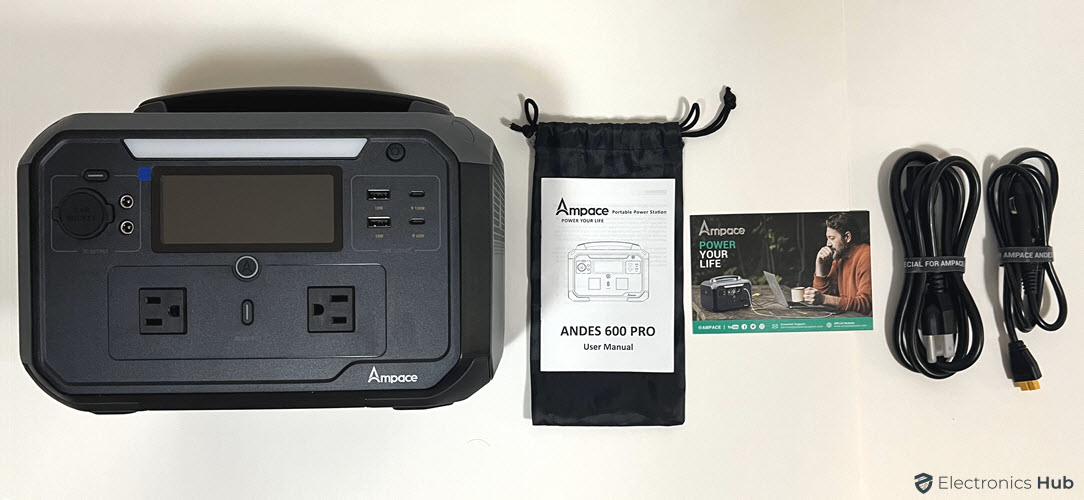
Then there is a small “Ampace-branded” bag with a couple of cables. One is the AC Mains Charging Cable and the other is DC Charging Cable suitable with car’s cigarette lighter port. There is a thick sponge protecting the power station from damage during transit. Taking out the top sponge, we get to the main event i.e., the Ampace Andes 600 Pro Portable Power Station. We will take a closer look at the design and ports of the unit in the next section.
Taking the Ampace Andes 600 Pro from its protective bag and holding it for the first time, we can feel its build quality. Measuring just 11.2inch × 8.4inch × 8.2inch (285mm × 214mm × 209mm) in terms of width, height, and depth and weighing just under 17lbs (7.6kg), the Ampace Andes 600 Pro is a compact unit. The top of the unit has a carry handle.
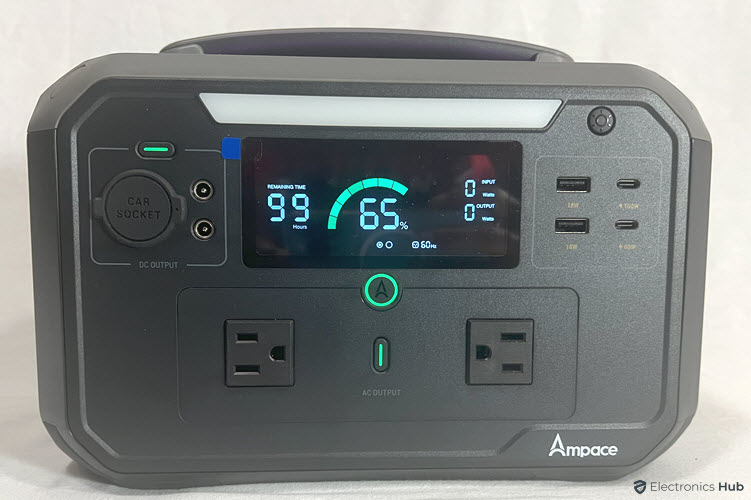
The front side of the unit is the busiest of all with an LCD display on the top, USB ports to the right of the display and 12V ports (car socket and barrel jack ports) to the left of the display. Just below the display, we have the AC Section with two sockets/receptacle. Both AC Output and 12V DC Output sections have respective on/off switches.
LCD on the Ampace Andes 600 Pro displays a lot of information. It shows remaining battery level and percentage, recharge time or remaining time, input and output power, a bunch of indicators for individual ports (AC, DC, USB, etc.), Wi-Fi, fan, Bluetooth, and some warning indicators.
There is an LED light above the display and the button to control this light is above the USB section. On the top, surrounding the handle, there is strip of LEDs. The left and right sides of the unit have holes for ventilation and there are two fans on the left side that help in cooling down the battery pack as well as the electronics.

On the back, we have two ports: one is the AC Input Port and the other is Solar/Car DC Charging Port (XT60 style).We have to charge the unit using these two ports.
The first and important part of any portable power station is its battery pack. Like many other portable power stations, even the Ampace Andes 600 Pro makes use of LiFePO4 battery hybrid system. Short for Lithium Iron Phosphate, LiFePO4 batteries represent a type of rechargeable lithium-ion battery known for their stable chemistry and long lifespan. The stability and safety of LiFePO4 batteries make them particularly useful in demanding environments and critical applications.
Unlike other lithium-ion batteries prone to thermal runaway or combustion, LiFePO4 batteries exhibit excellent thermal stability, reducing the risk of fire hazards even under extreme conditions. This characteristic makes them ideal for use in electric vehicles, where safety is paramount, and in off-grid solar installations or portable power stations, where reliability is crucial.

One of the primary benefits of LiFePO4 batteries compared to traditional batteries is their superior lifespan. LiFePO4 batteries can endure significantly more charge-discharge cycles, typically over 2000 cycles, without substantial capacity degradation. This longevity makes them a cost-effective solution in the long run, as they require fewer replacements over their operational lifespan.
Ampace Andes 600 Pro has a large 584Wh LiFePO4 Hybrid battery pack. The Andes 600 Pro retains over 80% of its capacity even in temperature as low as -20°C (-4°F). So, you don’t have to worry about the battery pack while using cold climates. Even if you discharge and charge the Ampace Andes 600 Pro one time every day for 5 years, then the battery pack will have roughly 400 – 450Wh of capacity after 5 years. This is all theoretical but you get an idea about the battery pack of the Ampace Andes 600 Pro.
A critical part of modern lithium battery packs (lithium-ion, lithium polymer, or LiFePO4) is the battery management system or BMS. Ampace Andes 600 Pro uses an EV-grade BMS that monitors and protects each and every cell in the battery pack from over voltage, over current, over temperature, over load, low temperature, low voltage and short circuit.
So, how was the performance of the Ampace Andes 600 Pro Portable Power Station? Let us begin with the design and handling of the unit. As we mentioned earlier, the device is quite compact and dense and weighs around 17 pounds (7.6kg). This is certainly not a lightweight unit but you can easily carry it around from car to the camp site or from inside your RV to a table outside.

Let us now see the actual performance starting with the USB Ports. With USB power, we can charge a plethora of devices such as smartphones, tablets, earbuds, headphones, laptops, cameras, etc. While almost all the devices have USB-C Ports nowadays for charging, the other end of this connection (on the charger) can be either the regular USB-A Port or USB-C. The Ampace Andes 600 Pro has totally 4 USB Ports of which two are USB-A and the remaining two are USB-C.
The two USB-A Ports support a maximum of 18W charging. The USB-C Port on the top supports a maximum of 100W while the one on the bottom is limited to only 60W. We tested all the USB Ports and they can deliver the rated power without any issues. We’ve mentioned all the voltages and currents of individual USB Ports in the specifications section for your reference.
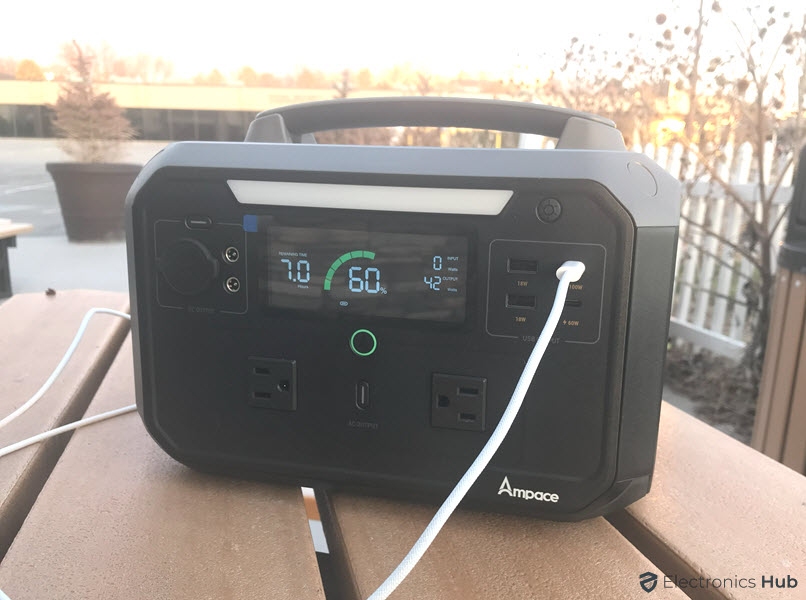
Next are the 12V Ports. We have three 12V Ports: one car cigarette lighter type socket and two DC 5521 Ports for connecting regular barrel jacks. While all the ports support a maximum of 10A for a power output of 120W, the maximum combined power output from all the three ports is only 120W. We tested the car socket with a bunch of car accessories (car vacuum cleaner and tire inflator) and it worked flawlessly. But we wish the power limit of 120W should have been at least 180W as these car accessories are pulling close to the full power under significant load.
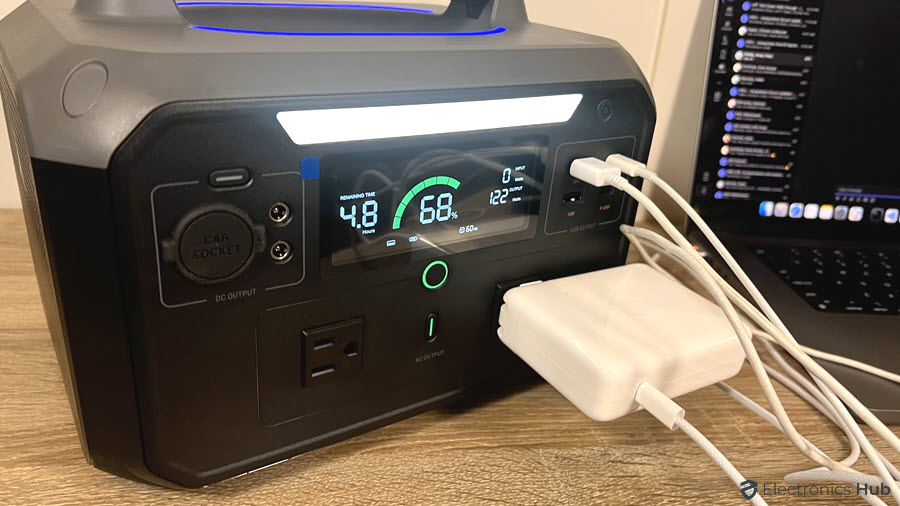
Next up, we have the inverter section with two AC Mains receptacles that output 120V @ 60Hz.It is a pure sine wave inverter that uses a special SiC (Silicon Carbide) technology to achieve up to 95% efficiency. The total power output from the AC section is 600W but there is an “A-turbo” mode where the surge power can be 1,800W. This is useful for appliances with motors such as small refrigerators or air conditioners which have different starting watts and running watts.
Charging wise, we have the standard AC Charging option with a maximum power input of 550W. It fully charges the 584Wh battery pack in just over 90 minutes. If you want a quick top up, then use the AC Charging for 1 hour and it will recharge to almost 80% of its capacity. This is okay if you have access to shore power but what if you are one the go? The Ampace Andes 600 Pro also supports DC Charging from both a regular car socket as well as solar using a standard XT60 connector. The Car Socket charging is the only option if you want to charge your power station while travelling in your car or RV. The maximum current we can supply through the car charging input is 8A and with 12V output from the car cigarette lighter socket, the maximum charging power is only 96W. It will take over 5 hours to fully charge the battery if you are going this route.

These two are the simple ways to charge this power station with accessories that come with the package (as it has both AC Charging Cable and Car Socket Charging Cable). If you are looking for a greener way to charge the power station, then you can use a solar panel and pair it with the unit. Keep in mind that the solar panel and the corresponding cable (an MC4 to XT60 Charging cable for the power station and an MC4 adapter cable) are additional accessories that we have to purchase separately.
The maximum solar input that the Ampace Andes 600 Pro Portable Power Station supports is 200W. With this power, you can expect the solar power to charge the battery of the power station anywhere between 3hoursand 5½ hours.
An interesting feature of this power station is Emergency Power System. If you connect the AC Charging Cable to the Ampace Andes 600 Pro, the AC output sockets will draw power from this cable instead of the battery/inverter. So, you will be using the grid supply to power devices. In the event of a power outage, the power station can switch on its AC Output and (almost) instantly and keeps the device running. The switching time is around 20ms. So, this might not be suitable for sensitive devices such as computers. If you are using medical device such as CPAP machines that need continuous power supply, then you can make use of the emergency power feature of the Andes 600 Pro and run the machine without worrying about it shutting off.

We used a lot of small appliances (a portable coffee maker and a small space heater) with the Ampace Andes 600 Pro and it worked as expected. Even with significant load, the fans of the power station didn’t make much noise.
While we can see most of the stats right on the LCD of the unit, the Ampace Andes 600 Pro comes with a companion app for smartphones that helps in wireless control and monitoring. You can check the input and output power, battery percentage, toggle the AC and DC outputs on or off, turn the LED on or off, change the ambient light, etc.
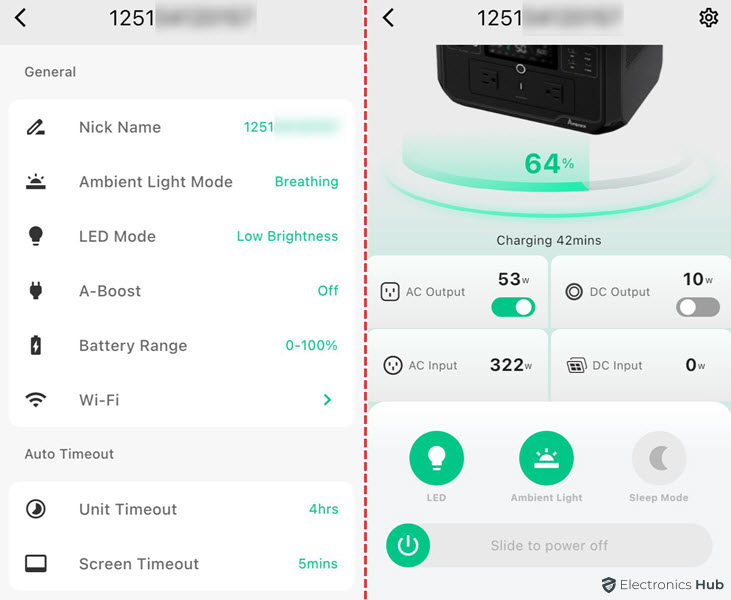
An additional feature that is available only with the app is Sleep Mode. In this mode, the unit will turn off the ambient light, reduces the fan speed, limits the AC Output power to 400W, disables A-turbo mode, and turns off the LCD after 10 seconds. This is very useful during night time to those who cannot sleep with distracting lights or noise.
The Ampace Andes 600 Pro Portable Power Station is available at a price of $449. This device comes with a 3-year warranty. At the time of reviewing this product, there is a 20% discount on the product with the use of a special code “2052K4Z1”. Use this code and get the product for approx. $359.
Overall, we are really impressed with the Ampace Andes 600 Pro Portable Power Station. It has decent number of ports in the form of USB-A, USB-C, Car Socket, DC Power Ports, and AC Sockets so that you can connect/charge a wide range of electronics and appliances. Charging wise, we can charge it using the regular AC Mains supply, Car Socket, and even connect a Solar Panel, if you want to go green.
The build quality is very good and it uses top-tier LiFePO4 Hybrid batteries with a typical cycle life of 2,000+. The battery pack is safe-guarded by an EV-grade BMS that protects the cells from a range of possible errors and issues.
If you are looking to invest in a decent portable power station for powering all your USB gadgets as well as small AC Mains appliances, then the Ampace Andes 600 Pro is a very good choice.
Get great content that you love. No ads or spams, we promise.
How To Guides
Product Reviews
For Students
Copyright © 2024 Electronicshub.org